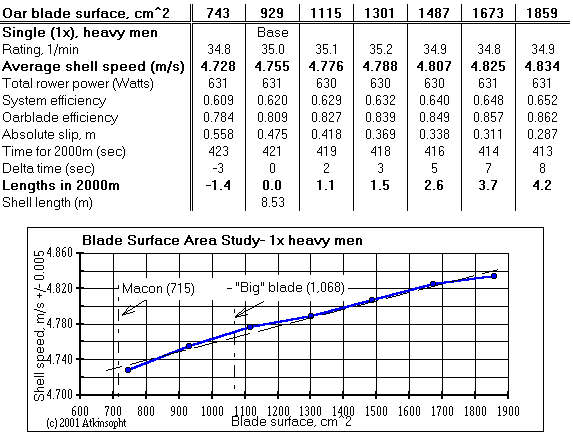Cast a vote here if you think it should move up in the Top-100 ranking:

You will be transferred to the Top-100 site, but may then return here by going "BACK"

Because of the effect of surface area on slip and speed it would seem mandatory to eliminate differences in blade surface area when comparison testing blades for other attributes.
Increased surface is limited, of course, by the addition of weight and the ultimate impossibility of handling and feathering the result. Further, ROWING yet has no way of modeling losses resulting from blade rotational resistance, which is assumed to be relatively small compared to slip loss but which must increase with blade surface.
Figure 1 shows ROWING's result for increased surface on the speed of a scull for identical geometries, forces, and total rower power. The benefit would apply to all boats. (ROWING accounts internally for increase in surface skin friction loss.) When rating is held constant the surface result is virtually the same showing that rating is very closly related to power.
 Figure 1
Figure 1
Surface increases should be relatively easy to arrange and cheap to fabricate. If cleverly done existing blades could be modified in the boathouse. The first step in this direction has been the transition from the Macon form to the "Big Blade" and the probable benefit will undoubtedly drive further increases aided by lighter materials and good design. Oar manufacturers must begin to publish surface area data in blade specifications as customers become increasingly interested in comparisons.
If I were a serious sculler, determined to improve my speed, experimentation with blades larger than those commonly available would be very high on my list.
Anecdotal information tells me that there is concern about a possible relation between increased blade surface and back injuries.
In regard to area increase Dreissigacker makes no attribution to the work first presented here- which appeared on the Web in 2001.
The effect of blade form (planform, camber, cant angle, and edge detail) is largely unknown because serious research (very expensive) has never been supported. My current view- from preliminary looks at blades with positive lift at zero attack angle- is that surface area will always dominate form effects.
The same conclusion has been reached by Marinus van Holst who has independently modeled the effect of blade surface "4. Variation of blade area.".
As area increases one must resist the temptation to relax the so-called "feel" of the pull. "Compensating" for increased surface by decreasing the length of the outboard lever simply increases the load at the blade (for the same handle pull) thus reintroducing the very slip the area change was asked to overcome (see the discussion on propulsive force).
NEW (03/02/2016):
See the Concept2 new small
Bantam blade
Even though the Bantam blade would never be in competition with the Fat2 it is
interesting to look into the effect of surface area change with two real blade models.
Details of this new blade area investigation in the ROWING model can be found
here .
And a discusion of results can be found here .
Oars may be getting longer. There is a best oar lever ratio for every rower's strength and blade surface. Strength and surface can be optimized to maximize propulsive force while minimizing slip--see the result in Oar Length and Lever Ratio which hints at a possible trend toward longer oars for heavy pullers.
This "area" page has been on the Web now for almost six years. Since increasing blade area seems a good thing to try (it strongly reduces slip) and- since arranging to try it is dead easy- it surprises me that I have had no feed-back yet on anyone who might have given it a test. How can it be that the really serious with a bit of funding (e.g., Olympians?) haven't had a go at this?
Contrary to my original suggestion (posted here until today) of increasing blade area overall, that is in width as well as in length, I now feel that area increase should involve increase only in aspect ratio: blades should be longer for the same width. This is because drag coefficient increases with aspect ratio and drag rules in reducing energy stealing blade slip.
So, to increase area merely add length to the tip. You could easily try this in the boathouse shop.
It might have been better to have morphed the Macon blade into a longer form than to have widened it to produce the Big Blade.
An infinite aspect ratio has a Cd=2.0. Thus a Macon blade, of the same surface area, might be preferable to a Big Blade. Who knows until we experiment? The traditional blades of fishermen and seamen have always been long and thin, perhaps a design honed by cultural evolutionary experience over tens of thousands of years. It was easier too, before the advent of lamination technology, to fashion a narrow blade from a given stick of wood.
And so we see the rise in popularity of the "Greenland" blade in kayaking; an extreme example of high aspect ratio. How long before it becomes the next new "thing" in rowing?
Speaking of feed-back- I notice on the web today (11/21/03) that
Concept-II is now speculating on the possible advantages
of increased blade surface area (and you saw it here in 2001!).